It wasn’t quite the quail of my last post, but when a local butcher, whom I’d requested to order me up some lambs’ tongues for a dish I was thinking about, told me he couldn’t get any, but, “hey, here, I have a couple of pig’s tongues that you can have”, I wasn’t going to look a gift pig in the mouth. I’ve never worked with them, other than chopped up with other head bits for making head cheese, something I did a whole once, somewhere, somewhen. A bit of research showed that they’re a common ingredient in several cuisines (the Chinese and Thai use them in various dishes). And before you go “ewwww”, keep in mind that unlike some of the glands and organs that might more commonly provoke that reaction, a tongue is just a muscle, like any other meat, though fairly tough, as it tends to get a hefty workout while attached to the animal.
Since I had two to work with, I decided to make one really classic French dish, and take the other and see if how it came out for the dish I was thinking about for the lamb version. By the way, not easy to find a music video that encompasses pigs and tongues…. And yes, I thought of “tongue-fu pig” before I spotted the video. A nice bit of synergy.
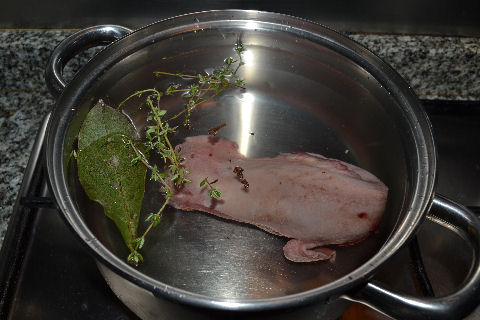
Simple, classic way to cook a pig’s tongue (or, for that matter, pretty much any tongue that we might be about to turn into a dish). Into a pot with water, a bay leaf, some thyme sprigs, and a couple of cloves; covered, and over low heat, brought to a bubble and cooked for four hours over the lowest heat you can manage and keep it just barely simmering. You’ll likely have to top it up with water a couple of times.
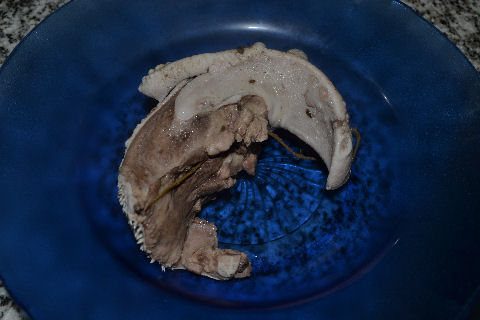
Let it sit to cool for about ten minutes, just enough to be able to handle it. Peel/scrape off the skin, the off-white covering that is over the entire upper surface and part of the lower.
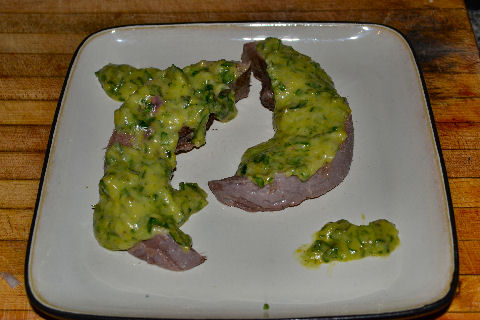
Somewhere towards the end of the above, maybe during the ten minute “cooling” time – make a sauce ravigote. Basically, it’s a mixed herb, mustard and caper sauce. I put olive oil, white wine vinegar, salt, pepper, dijon mustard, capers, shallot, parsley, oregano, and chives into a blending cup and used the hand blender pulsed a few times until it was all coarsely chopped and just emulsified. Cut the still warm tongues in half lengthwise, and spoon the sauce over them. Some things are just so delicious it’s no wonder they’re classics.
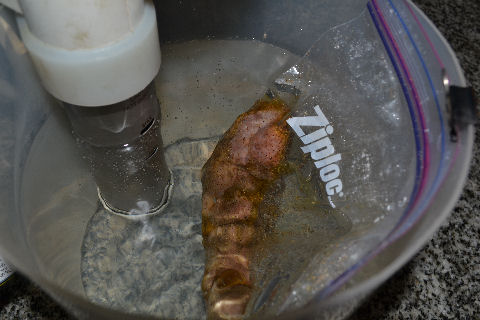
That was old school, how about new school? An inspiration from the classic Peruvian anticuchos. Packed into a ziploc bag with olive oil, salt, black pepper, and cumin. Air removed, sous vide cooked at 68°C (155°F) for 12 hours. Yes, 12 hours. Basically, I just put it in mid-evening, topped the water up before going to bed, and took it out in the morning.
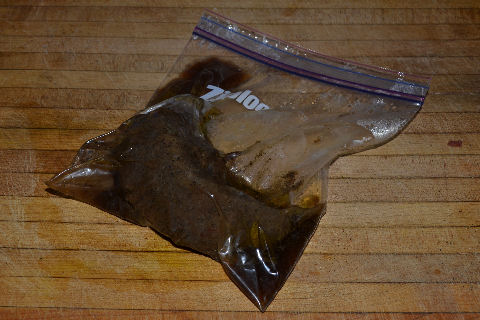
Cooked but still firm (versus the sous vide method for making shredded “braised” tongue for things like tongue tacos, which is all the rage these days – that’s cooked at a higher temperature for 24-48 hours, leaving meat that’s falling apart tender). Chilled for a couple of hours. One of the interesting things, most of the skin simply dissolves, or becomes as tender as the meat, in this process, there was very little that needed to be removed.
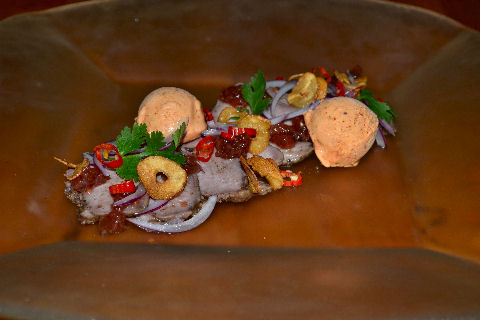
Ain’t that purty? Let’s see – slices of the tongue; smoked chili gelato (merquén, ají panca, ají rojo powder, smoked salt in place of plain); red onion slivers; fried garlic slices; rounds of ají limo chili; red wine vinegar fluid gel; cilantro. Purty, and geez that’s good.
Guess I’m going to be serving up pigs’ tongues in one guise or another in some upcoming dinners.
Are you still using the Nomiku that you wrote about at https://www.saltshaker.net/20140730/first-stabs-at-sous-vide?
Yes, I actually have two of them now!